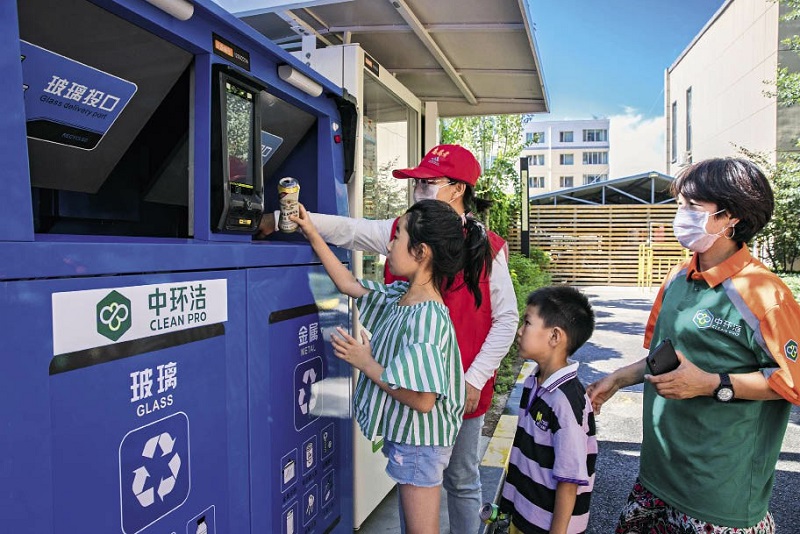China’s Momentous Carbon Neutrality Goal

China has made dramatic changes in carbon emission reduction over the past five years, giving itself more confidence of meeting its future targets.
China aims to reach peak carbon emissions before 2030, and to become carbon neutral before 2060. This goal will lead to profound changes in the country’s social and economic development.
Meaningful Goals
When it comes to addressing climate change, China has a decisive influence on achieving global goals. With a large population and a large economy, it is also a big greenhouse gas emitter. How far China’s bold pledge goes will determine how much the global climate change goals could be achieved.
The United States officially withdrew from the Paris Agreement after the latter entered its fifth year in force. The COVID-19 pandemic has also made many people confused about whether the agreement can continue. At this moment, China’s pledge indicates strong support for the agreement. It will not only redefine China’s leading role in mitigating climate change, but also has a significant impact on geopolitics, global governance, and the world order in general.
Domestically, the carbon neutrality target will determine the direction of China’s future economic development. At present, China is formulating its 14th Five-Year Plan (2021-2025). As the COVID-19 epidemic has been effectively contained at home, China is seeing a recovering economy. The announcement of carbon emission reduction targets at this particular moment could hopefully change the entire structure of the economy in the future. We can expect a radical shift in China’s coal-based energy landscape as the renewable energy industry will embrace more development opportunities, while coal mining and coal burning for power generation will be gradually phased out.

Well Prepared
The proposed carbon targets are based on China’s decades-long efforts to reduce carbon emissions. As early as 2015, the Chinese government submitted to the United Nations Enhanced Actions on Climate Change its Intended Nationally Determined Contributions goals.
Through multiple efforts, China has made great progress in carbon emission reduction. At the end of 2019, the carbon intensity was 18.2 percent lower than that of 2015, fulfilling the binding targets set in the 13th Five-Year Plan (2016-2020) ahead of schedule.
In terms of technology, China has made major breakthroughs in a number of fields. In the past decade, for example, the cost of renewable energy production fell sharply, with the cost of photovoltaic power falling by 90 percent to below that of coal. Green electricity generated by renewable resources can already compete with that of coal. Industrial energy efficiency has also improved significantly. China’s digital and information technology have risen to prominence and been widely used, accelerating the adjustment of the energy structure.
China’s commitment to green development and efforts to promote environmental progress embody its mission to cut carbon emission. In terms of economic policies, more emphasis is placed on the transformation of economic growth patterns. There has also been very good synergy between economic and environmental policies.
It is fair to say that China has made dramatic changes in carbon emission reduction over the past five years, giving itself more confidence of meeting its future targets.

Transformation and Development
To achieve the carbon neutrality goal, China will need to make profound changes in all areas.
In the energy sector, the share of coal in energy consumption will fall to 10 or even less than five percent. For now, Qinghai Province in northwest China offers a perfect example. Qinghai has a unique energy mix, rich in wind, solar energy, and water resources; its clean energy accounts for 87 percent of the total. Each year, there are 100 days when power is generated solely by clean energy. The development potential of renewable energy has reached three billion kilowatts, and its direct exploitation potential now reaches one billion kilowatts.
In September 2020, the first ultrahigh-voltage direct current transmission channel to deliver clean energy from Qinghai to other regions was connected to Henan Province in central China. In the future, Qinghai, Gansu, Ningxia, Inner Mongolia, and other western provinces and regions will become bases for clean energy generation, thus changing China’s energy supply map.
Another concern is how provinces and regions with rich natural energies will transform. Today, Inner Mongolia, on the one hand, is vigorously developing its wind power industry to increase the proportion of green electricity. On the other hand, great efforts have also been made to build big data centers to explore new growth momentums. These efforts will help hedge against the impact of coal reduction on the economy and society. The transformation of the energy mix is a long process that may take five, 10 or more years. It involves a large number of workers being moved away from high-carbon industrial chains such as coal mining. For workers in traditional industries, training opportunities should be provided to help them transfer to other posts smoothly. For older workers who have difficulty in transferring posts, the social security system should be improved to minimize the adverse effects brought about by laying them off.
In the renovation of old cities and the construction of new urban areas, we should follow a low-carbon principle and improve the transportation infrastructure, especially making public transportation more convenient. Now in Shenzhen, taxis and buses are fully electric; other big cities should also use more electric vehicles. We should continue to promote the use of trains instead of trucks, and the combined use of railways and ports for long-distance deliveries.
Presently there are also many key technologies being developed in industries. For example, as stocks of scrap steel increase, replacing iron ore with short-process steel made from scrap steel could save a lot of energy. Besides, when the reducing agent in steel making is changed from coal and coke to hydrogen, there will not be any carbon emissions produced. R&D of low-carbon and even zero-carbon cement is also under way. In addition, the manner in which the coal-based chemical industry becomes hydrogen-based is also undergoing much research at present.
The transformation of the construction sector should be closely combined with China’s urbanization process. In the future, hundreds of millions of Chinese farmers will migrate to cities. Ruicheng City in Shanxi Province, Shenzhen and other cities are piloting zero-carbon and flexible buildings. Photovoltaic panels are installed on the roof and facade of buildings, direct current distribution networks are installed, and energy storage batteries are equipped to realize self power supply, refrigeration, and heating of the building. In the future, it will be trendy to build more residential communities and industrial parks with zero-carbon emissions.
In the agricultural field, the development potential of photovoltaic agriculture is huge. For example, installing photovoltaic panels in the deserts of Qinghai Province could not only generate electricity, but also reduce the evaporation of desert water. By washing those photovoltaic panels, wasteland irrigation can be increased, and grassland area coverage can be increased. The locals put sheep under the panels to graze, and a comprehensive ecological cycle of water, grass, photovoltaic power, and livestock is established.
Qingdao in east China’s Shandong Province is also exploring the development of photovoltaic agriculture, with local farmers planting mushrooms under solar panels, dramatically increasing farmers’ income.
At present, China still has a large low-income population in rural areas. Therefore, exploring new energy-related industries is also a way to help them generate more income.
The author is CEO & president of Energy Foundation China.
 Facebook
Facebook
 Twitter
Twitter
 Linkedin
Linkedin
 Google +
Google +










